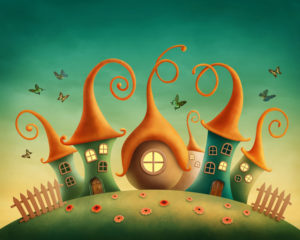 NICE BOSS, TOUGH BOSS: A FAIRY TALE
NICE BOSS, TOUGH BOSS: A FAIRY TALE
Fairy tale mindsets create a powerful lens through which we view leadership. Do you let them affect how you act as a leader? If so, you may be leaving a piece of your potential effectiveness on the table. (And live less happily-ever-after.)
The stories of goodness and evil we were raised on predispose us to see leaders along a “mental continuum”. At one end dwells the classic tough boss. This boss is demanding, brimming with strong opinions, fearless, scheming, and wants (badly) to win. She brooks no fools, and is perceived as difficult to interact with.
Think of the gruff and coercive Beast early in Beauty and the Beast: “You will join me for dinner. That is not a request.” Or how mean monsters crawl into closets and spook children at the start of Monsters, Inc, bottling the resulting screams to power their city, Monstropolis.
On the other end of our good vs. evil leadership continuum lives the lovable leader. This person is highly caring, fun, has time to listen, and is quick to wink, encourage, and thank. He relishes strong relationships, and often has a good sense of humor to boot. Think Prince Simba early in the Lion King as he wanders off to savor a carefree life with his (many) friends in the wild. Simba’s discomfort with flexing his muscles or being strong is palpable, so he chooses a life of “nice.”
WHERE DO YOU NEED TO DWELL ON THIS LEADERSHIP CONTINUUM?
As a boss: where do you sit on this continuum? (Or more importantly, where do your direct reports and colleagues think you are?) Is your big challenge figuring out the optimal place to hang out on this “Tough Guy vs. Nice Guy” scale?
Absolutely not.
Your challenge is to dismiss the whole scale. To recognize that it is a problematic fairy tale itself that doesn’t serve you or your teams. The world’s most effective bosses realize that they can be very very tough AND very very caring during the same workday, or even during the same conversation. They defy physics by living on both ends of our described scale simultaneously.
Just think back to your favorite boss. Chances are, she challenged you to jump high… and didn’t always make popular, easy decisions. However, you knew she genuinely liked and supported you, and as a result you were fiercely loyal.
DIAGNOSING YOUR CURRENT APPROACH
 How do you know if you’re dishing up enough love but not enough tough “edge?” Or enough toughness, but not enough love?
How do you know if you’re dishing up enough love but not enough tough “edge?” Or enough toughness, but not enough love?
The best place to start is with feedback from your team. Ideally – confidential 360 feedback collected through a 3rd party. This will give you a candid view of how your direct reports, peers, boss, and others at work view you.
In my leadership and coaching programs, I work frequently with individuals who find via 360 feedback that they need to shore up one side – or the other – of their “tough AND caring” equation.
For example, one recent client (we’ll call him Beast for now) was universally viewed as super smart, fiercely competitive, able to make tough decisions, and fast moving…yet others didn’t trust him and didn’t feel he had their best interests at heart. He had what they labelled “rough edges.” Several team members said they would leave his group the moment another viable work option materialized.
Another recent client (we’ll call her Simba) was very well-liked. She provided lots of flexibility, was a good listener, and had an endearing sense of humor. But her team didn’t feel successful, and their collective results were flagging. They didn’t feel they were learning from her or growing professionally, as much as they enjoyed her and all the leeway she gave them.
CAN WE REALLY BUST OUT OF THIS “TOUGH VS. NICE” MYTH?
Luckily a number of my clients have proven via their 360 results — either with or without conscious efforts to change – that it is possible to be seen as strong, demanding, caring, and fun all at once. Those who proved this typically ran the most successful operations as measured by profitability, growth, employee retention, and client satisfaction.
But aren’t tough and caring tricky to bring together?
Once upon a time, the poet Walt Whitman said “Do I contradict myself? Very well, then I contradict myself. I am large, I contain multitudes.”
Leaders must cultivate their own unique “multitudes” of emotions and behaviors. And avoid casting themselves as one-dimensional (but comfortable) leadership stereotypes.
Eventually our fairy tale characters Simba and Beast got their happy endings. They dug deep in themselves to find their own multitudes. They broadened their approaches. Prince Simba realized that he needed his strength (as well as his kind heart) to help his fellow creatures. And Beast softened, learning how to better connect not just with Beauty, but the rest of his world.
So may your leadership “happily ever after” periodically involve an honest, active quest to identify and cultivate whatever you most need at the time – be it greater strength, or greater heart. It will serve you well.
THE END.
 Why do many leadership development programs fail?January 15, 2023
Why do many leadership development programs fail?January 15, 2023 Suspect Your New Hire Won't Make It? 4 Mistakes to AvoidMarch 15, 2023
Suspect Your New Hire Won't Make It? 4 Mistakes to AvoidMarch 15, 2023
1 comments